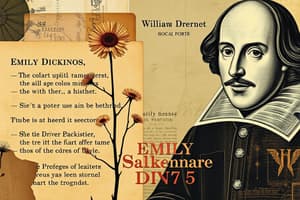Podcast
Questions and Answers
What is the typical tone of a haunted house poem?
What is the typical tone of a haunted house poem?
- Optimistic and uplifting
- Romantic and sentimental
- Ominous and foreboding (correct)
- Humorous and lighthearted
What does the old, abandoned house typically represent in a haunted house poem?
What does the old, abandoned house typically represent in a haunted house poem?
- A place of learning and growth
- A place of beauty and wonder
- A place of happiness and joy
- A place of decay, neglect, and forgotten memories (correct)
What poetic device is used to compare the house to a living being in a haunted house poem?
What poetic device is used to compare the house to a living being in a haunted house poem?
- Imagery
- Metaphor (correct)
- Personification
- Alliteration
What is the effect of using creaking doors and floorboards in a haunted house poem?
What is the effect of using creaking doors and floorboards in a haunted house poem?
Which of the following poems is NOT an example of a haunted house poem?
Which of the following poems is NOT an example of a haunted house poem?
What do cobwebs and spiders often symbolize in a haunted house poem?
What do cobwebs and spiders often symbolize in a haunted house poem?
What is the effect of using shadows and darkness in a haunted house poem?
What is the effect of using shadows and darkness in a haunted house poem?
What is the main theme of a haunted house poem?
What is the main theme of a haunted house poem?
Flashcards are hidden until you start studying
Study Notes
Poem: Haunted House
Overview
- A poem about a haunted house, exploring themes of fear, supernatural presence, and the unknown.
- Typically written in a spooky and atmospheric tone to create a sense of eeriness.
Common Imagery and Symbolism
- Old, abandoned house: Represents a place of decay, neglect, and forgotten memories.
- Cobwebs and spiders: Symbolize the passage of time, neglect, and the eerie feeling of being watched.
- Creaking doors and floorboards: Create a sense of tension and foreboding, hinting at the presence of an unseen force.
- Shadows and darkness: Represent the unknown, fear, and the supernatural.
Poetic Devices
- Imagery: Used to create vivid descriptions of the haunted house, engaging the reader's senses.
- Metaphor: Comparing the house to a living being, emphasizing its eerie and supernatural nature.
- Personification: Attributing human-like qualities to the house or its objects, creating an unsettling atmosphere.
Tone and Atmosphere
- Ominous and foreboding: Creating a sense of tension and fear, hinting at the supernatural presence.
- Eerie and unsettling: Using language to create an uncomfortable and spooky atmosphere.
- Mysterious and intriguing: Encouraging the reader to explore the unknown and the unexplained.
Examples of Haunted House Poems
- "The Haunted House" by Edgar Allan Poe: A classic example of a haunted house poem, exploring themes of death, loss, and the supernatural.
- "The Witch" by Mary Elizabeth Coleridge: A poem that uses imagery and symbolism to create a sense of eeriness and foreboding, hinting at the presence of a witch in the haunted house.
Haunted House Poem
Characteristics
- Typically written in a spooky and atmospheric tone to create a sense of eeriness
- Explores themes of fear, supernatural presence, and the unknown
Imagery and Symbolism
- Old, abandoned house: represents decay, neglect, and forgotten memories
- Cobwebs and spiders: symbolize passage of time, neglect, and the eerie feeling of being watched
- Creaking doors and floorboards: create tension and foreboding, hinting at the presence of an unseen force
- Shadows and darkness: represent the unknown, fear, and the supernatural
Poetic Devices
- Imagery: used to create vivid descriptions of the haunted house, engaging the reader's senses
- Metaphor: compares the house to a living being, emphasizing its eerie and supernatural nature
- Personification: attributes human-like qualities to the house or its objects, creating an unsettling atmosphere
Tone and Atmosphere
- Ominous and foreboding: creates a sense of tension and fear, hinting at the supernatural presence
- Eerie and unsettling: uses language to create an uncomfortable and spooky atmosphere
- Mysterious and intriguing: encourages the reader to explore the unknown and the unexplained
Examples of Haunted House Poems
- "The Haunted House" by Edgar Allan Poe: explores themes of death, loss, and the supernatural
- "The Witch" by Mary Elizabeth Coleridge: uses imagery and symbolism to create a sense of eeriness and foreboding, hinting at the presence of a witch in the haunted house
Studying That Suits You
Use AI to generate personalized quizzes and flashcards to suit your learning preferences.




